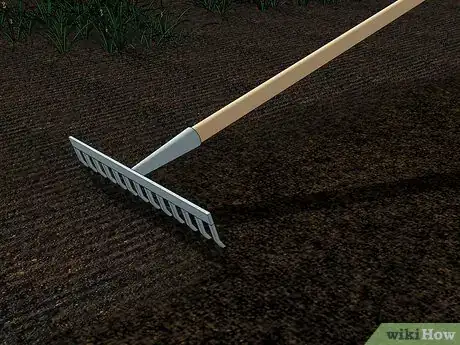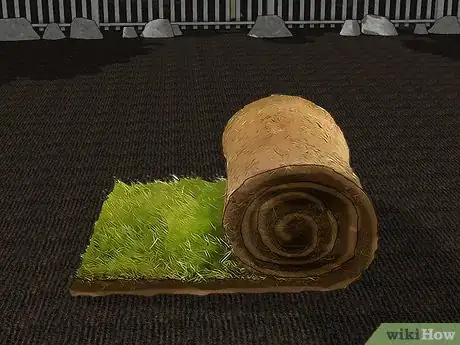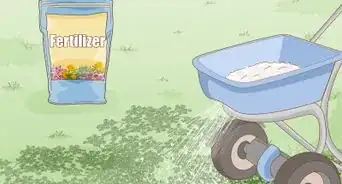This article was co-authored by Ben Barkan. Ben Barkan is a Garden and Landscape Designer and the Owner and Founder of HomeHarvest LLC, an edible landscapes and construction business based in Boston, Massachusetts. Ben has over 12 years of experience working with organic gardening and specializes in designing and building beautiful landscapes with custom construction and creative plant integration. He is a Certified Permaculture Designer, is licensed Construction Supervisor in Massachusetts, and is a Licensed Home Improvement Contractor. He holds an associates degree in Sustainable Agriculture from the University of Massachusetts Amherst.
This article has been viewed 28,476 times.
Sometimes, conditions like drought can cause the grass in your lawn to stop growing. This can be frustrating, especially if you enjoy a luscious backyard. Luckily, relaying your lawn is an option. With a little elbow grease, you can make your lawn look brand new. To start, ready the soil by removing weeds and evening out the ground. Then, purchase some sod at a greenhouse or online and distribute it throughout your lawn. Wait a few weeks before beginning to water and mow your new lawn. When you're done, you will have a beautiful new lawn to enjoy.
Steps
Restoring the Soil
-
1Remove weeds and stones from the soil.[1] You want to make sure you lay down your new lawn on a hospitable surface. Walk across your lawn and pull up any weeds you see. If you notice any rocks, stones, or other obstructions, remove them as well.[2]
- It's a good idea to wear thick gardening gloves during this process to protect your hands.
-
2Apply new topsoil to uneven areas on the lawn. If your lawn has any uneven places where the soil levels are low or dip down, you will need to apply new topsoil. You can purchase topsoil online or at a local greenhouse.[3]
- To apply new topsoil, start at the furthest part of the lawn. Cut open a bag and place it in a wheelbarrow. Run the wheelbarrow over your lawn, gradually releasing topsoil on the barer areas.[4]
- Topsoil generally comes in large bags. Do not stack bags on top of one another, as this can cause topsoil to spill out too fast.
Advertisement -
3Level out the soil.[5] After applying new topsoil, your lawn will likely be a little uneven. To fix this issue, start by simply walking across your lawn in varying directions until the soil begins to even out. After the soil is relatively even, take a rake and run it through all portions of your lawn to get the soil on a nice, even level. As with walking, rake the soil several times and in varying directions to allow it to level out.[6]
-
4Apply fertilizer to the soil.[7] You can purchase fertilizer at a local greenhouse or online. Go for a general purpose fertilizer, which should be safe for most soil types. Usually, you apply 70 grams of fertilizer per square foot (2 ounces per square yard).[8]
- The 70 grams/2 ounces is a general estimate. While it may be true for many all purpose fertilizers, rates can sometimes vary. Do not apply your fertilizer without checking the bag first for precise measurements.
EXPERT TIPJeremy Yamaguchi is a Lawn Care Specialist and the Founder/CEO of Lawn Love, a digital marketplace for lawn care and gardening services. Jeremy provides instant satellite quotes and can coordinate service from a smartphone or web browser. The company has raised funding from notable investors like Y Combinator, Joe Montana, Alexis Ohanian, Barbara Corcoran and others.Lawn Care Specialist
 Jeremy Yamaguchi
Jeremy Yamaguchi
Lawn Care SpecialistUse a soil testing kit first. Adding the wrong type of fertilizer can do more harm than good. Soil testing kits are game-changers at determining what your soil needs in a fertilizer.
- Make sure you're applying the fertilizer at the right time. Spring is the perfect time to do that. Many people make the mistake of adding nitrogen in the fall, but this can stimulate leaf growth and make those plants susceptible to frost damage.[9]
Laying Down the Sod
-
1Measure your lawn. If you do not know how big your lawn is, use a measuring tape to measure it so you know its dimensions. When purchasing sod, purchase enough sod to cover your lawn.
- You may want to purchase a little extra sod, just in case any pieces get damaged.
-
2Purchase the right sod for your lawn. When buying sod, choose a buyer who can deliver straight to your door. Quality sod should come from raised seed and be drought-tolerant.[10]
- Sod comes in different varieties, so pick a sod type that works for you. If you just use your lawn for day-to-day activities, go for domestic sod. However, if you show your lawn as part of landscaping competitions, go for fine sod.
- Find a buyer with a good reputation by reading reviews online. If you know anyone who does a lot of gardening or lawn work, you can ask them for a recommendation.
-
3Lay down your first piece of sod. Find a straight edge in your lawn, such as near the edge of your house, to lay down your first piece of sod. Place the first piece of sod in the corner where you're starting and very slowly unroll it.[11]
- Plan to lay sod in the spring.
-
4Create your first line of sod. After laying down your first piece, you want to create a line running across your lawn. To do so, lay down one piece of sod at a time until you reach the edge of your lawn. Make sure to lay each new piece close to the piece behind it so there are no gaps in your line. Continue laying down sod in this fashion until you reach the edge of your lawn or property line.[12]
- Try to avoid walking directly on sod, which can damage it. After laying it down, pat it down with your hands to eliminate air pockets.
-
5Stagger the second line next to the first line. Lay down the second line in the same fashion you laid down your first, but arrange the pieces so the outline of each piece does not line up perfectly against its companion in line one. The effect should be staggered like bricks. The pieces of sod in the second line should be pushed right up against the sod in the first line. You do not want any bare gaps of soil in your lawn.[13]
-
6Continue this pattern. Keep laying down additional lines of sod until your lawn is covered. Keep gaps between sections of sod small to prevent bare patches in your lawn.[14]
- Not all your lines will include the same amount of sod, especially if your lawn is not an even square shape. Expect to have to use more or less sod on different portions of your lawn.
- Do not water the sod after laying it down. Avoid tampering with new sod for the first three weeks it's in place.
-
7Cut and set the sod. After your lawn is fully covered in grass, trim the sod pieces in the corners into half-moon shapes. Then, scoop up a few handfuls of soil. Place handfuls of soil underneath all the sod pieces on the edge of your lawn. This prevents the sod from drying out.[15]
- Use a lawn roller to help set the sod and press it flush with your soli.
Caring for Your Lawn
-
1Keep off your lawn for the first three weeks. For the first three weeks, avoid walking on your lawn. Only step on the sod if it's absolutely necessary. It's important to give your sod two to three weeks for the roots to set into the lawn.[16]
-
2Water your lawn frequently during dry weather. Water your new sod daily until rain arrives. Once it rains, water your lawn every five to 10 days during the summer months. During other months, water the lawn every 14 days if the weather becomes dry.[17]
-
3Start mowing when the blades are at the proper height. Do not mow your sod right away. Wait until the blades are 2 inches (5 centimeters) high to start mowing. When you do mow the lawn, set the blades on your mower high.[18]
-
4Troubleshoot common issues. After laying down your new lawn, you may run into common problems. Certain areas may not be thriving or you may notice pests infecting your lawn. If you notice any issues, take steps to address them promptly.[19]
- If any areas of your lawn are not growing, do a soil test. You can purchase a soil test at a local greenhouse. If your lawn's soil levels are too basic or acidic, you may have to add an appropriate plant-based compound to treat the issue.
- If you notice pests, choose a safe pesticide to apply to your lawn. Preventative pesticides are usually applied in the spring, while curative ones are applied in the fall. If you're worried about chemicals, there are many organic options on the market.
- If the grass in shady areas is not thriving, trim the surrounding trees and bushes. This will provide your grass with access to the sun.
Expert Q&A
-
QuestionWhat month is best to lay turf?
 Maggie MoranMaggie Moran is a Professional Gardener in Pennsylvania.
Maggie MoranMaggie Moran is a Professional Gardener in Pennsylvania.
Home & Garden Specialist The best time of year to lay turf is in the autumn, which is typically the months of September and October in the U.S.
The best time of year to lay turf is in the autumn, which is typically the months of September and October in the U.S. -
QuestionHow do you prepare the ground to lay turf?
 Maggie MoranMaggie Moran is a Professional Gardener in Pennsylvania.
Maggie MoranMaggie Moran is a Professional Gardener in Pennsylvania.
Home & Garden Specialist First, clean the area to remove all turf and weeds. After this, turn the top layer of soil with a spade or rotary hoe. Before laying the turf, apply some gypsum to help the roots of the turf. Use topsoil and apply a good layer—typically a sandy loam is best. Use a roller in order to create a flat and smooth surface, then lay the turf when the ground is cool.
First, clean the area to remove all turf and weeds. After this, turn the top layer of soil with a spade or rotary hoe. Before laying the turf, apply some gypsum to help the roots of the turf. Use topsoil and apply a good layer—typically a sandy loam is best. Use a roller in order to create a flat and smooth surface, then lay the turf when the ground is cool. -
QuestionCan you lay turf on top of old grass?
 Maggie MoranMaggie Moran is a Professional Gardener in Pennsylvania.
Maggie MoranMaggie Moran is a Professional Gardener in Pennsylvania.
Home & Garden Specialist No, you can't lay turf on top of old grass. If you do this, the new turf will never take root.
No, you can't lay turf on top of old grass. If you do this, the new turf will never take root.
References
- ↑ Ben Barkan. Professional Gardener. Expert Interview. 14 April 2020.
- ↑ http://www.bbc.co.uk/gardening/basics/techniques/lawns_layingturf1.shtml
- ↑ http://www.gardenersworld.com/how-to/maintain-the-garden/how-to-lay-lawn-turf/
- ↑ https://www.homebuilding.co.uk/how-to-lay-a-lawn/
- ↑ Ben Barkan. Professional Gardener. Expert Interview. 14 April 2020.
- ↑ https://www.rhs.org.uk/advice/profile?PID=410
- ↑ Ben Barkan. Professional Gardener. Expert Interview. 14 April 2020.
- ↑ https://www.rhs.org.uk/advice/profile?PID=410
- ↑ Ben Barkan. Professional Gardener. Expert Interview. 14 April 2020.
- ↑ http://www.bbc.co.uk/gardening/basics/techniques/lawns_layingturf1.shtml
- ↑ http://www.bbc.co.uk/gardening/basics/techniques/lawns_layingturf1.shtml
- ↑ http://www.bbc.co.uk/gardening/basics/techniques/lawns_layingturf1.shtml
- ↑ http://www.bbc.co.uk/gardening/basics/techniques/lawns_layingturf1.shtml
- ↑ http://www.bbc.co.uk/gardening/basics/techniques/lawns_layingturf1.shtml
- ↑ http://www.bbc.co.uk/gardening/basics/techniques/lawns_layingturf1.shtml
- ↑ https://www.homebuilding.co.uk/how-to-lay-a-lawn/
- ↑ https://www.rhs.org.uk/advice/profile?PID=410
- ↑ http://www.gardenersworld.com/how-to/maintain-the-garden/how-to-lay-lawn-turf/
- ↑ http://www.consumerreports.org/cro/magazine/2014/05/how-to-fix-the-5-most-common-lawn-problems/index.htm








































































